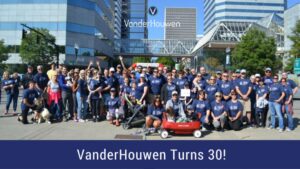How to Write an Effective Job Post: Part 1
Whether you’re a first time hiring manager or a seasoned HR veteran, crafting an effective job post is essential to recruiting and retaining top talent. In this two-part blog series, we’ll discuss what key elements and methodologies are required of a successful job post.
Today’s job market is candidate driven. This means that employee engagement shouldn’t begin on a new hire’s first day, but should start at the very beginning of the recruitment process. To attract top talent, you must effectively communicate your company’s mission and values, make clear what qualifications and responsibilities are required of a role, and put forth your “brand” during every step of the hiring process. Take a look at these insights from Deloitte University on employee engagement:“Organizations that create a culture defined by meaningful work, deep employee engagement, job and organizational fit, and strong leadership are outperforming their peers and will likely beat their competition in attracting top talent.”
-Deloitte University Press 2015 study
Finding the right talent for your organization starts with creating a thoughtful, engaging, and well-written job posting. So how do you write an effective job post?Grab the reader’s attention
The most valuable real estate is at the top of any job post—so use this space to sell your brand. Let potential candidates know about your company, what makes you unique, and what your organization’s mission and values are. Include an overview of your company and how this position perfectly fits in with your overarching goals.Describe the company
Think about what makes your company distinctive, and what kind of candidate would be the perfect fit. What industry are you in? Are you a large enterprise or a startup? What does your organization value? The more thoughtful and authentic your messaging is, the better. Here’s the first paragraph of an Accounting Intern job posting from Moss Adams’ website:“The instant you walk through our doors, you’ll feel it. We’re not your typical public accounting firm. Our business is dynamic, our client base is diverse, and our people are energetic and engaged. It’s not a coincidence. Moss Adams LLP runs on talent. We invest in our people because we know our success is built on yours. That’s why starting your career at Moss Adams will get you where you want to go – fast.”
Talk about attention grabbing! Note how they describe themselves—a dynamic public accounting firm—but speak from the perspective of the applicant and bring value to every word.Ask a question
Consider starting off the job post by writing a question that grabs a candidate’s attention while showcasing the value of working at your company. For example, “Wonder what it’s like to work at a vibrant accounting firm with multiple international entities?" In this case, the sell is specific—it introduces the company as an accounting firm, uses an engaging adjective, and makes note of the company’s international presence. It’s a great way to talk about the organization while asking the candidate to picture themselves at your company.Include your mission statement
What’s your mission statement? Candidates, especially millennials, are interested in learning about the “why” behind your brand. According to Deloitte University Press, “Mission-driven” companies have 30 percent higher levels of innovation and 40 percent higher levels of retention, and they tend to be first or second in their market segment.” Maybe you’re a women-run organization, or you value corporate responsibility, or your focus is on diversity and inclusion. Communicate this to potential candidates. While the job duties and qualifications for an Internal Audit Manager, for example, are similar across the board—it’s the insight into the company’s values that makes for a unique and creative job post.Match your tone of voice to your organizational values
Don’t just tell, show! An easy way to communicate your company’s vision and values is through the language you use in the job post itself. If you’ve positioned your company as a young, fun, innovative startup, don’t write a dry job post. Get creative with how you describe the position. Consider reworking a fun aspect of your company’s environment as a “qualification” for the position, i.e. “Loves playing with dogs around the office.”Describe the position
This next section of your job posting will focus on the position itself. Think about this section in two ways: you’ll want to give the candidate a sense of how the position fits into the organization at a high level, but also clarify what specific responsibilities will be expected of them.Type of position
Your candidates are interested in what type of role they are filling. A newly created position, for example, may indicate that a company is growing their business or expanding into new areas. In this case, you can say something like “As our organization continues to grow, we’re looking to fill a new role that will be instrumental to supporting the leadership team with financial decisions.” Describe how the role will benefit the organization. Likewise, if it isn’t a new position, then you likely have a clear vision of what achievement looks like in the role. Put that in! Describe the history of that position and how it has contributed to the success of your organization it the past.Type of role
You should also make clear how this role fits into your organizational hierarchy. Is this an executive role? If so, it’s more important to focus on the high-level, strategic requirements of the position, as opposed to day-to-day tasks. Consider describing if the position involves leading a department, mentoring employees, managing a team, overseeing financial strategy, business partnering, etc. For support/administrative jobs, like adding a staff member to your payroll team, focus more on specific, day-to-day tasks. Make clear what team members they’ll be supporting and what specific deliverables they’re expected to produce.Be clear about responsibilities
According to Glassdoor, 67% of employers believe retention rates would be higher if candidates had a clearer picture of what to expect from working at the company before taking the job. Get specific about requirements, schedules, leadership, and deliverables of the role. This will help minimize confusion and make for a more seamless onboard. These initial steps are sure to get you well on your way to crafting an effective job post. Stay tuned for Part 2 in which we’ll discuss how to determine qualifications, do the appropriate research, and test for success.While you wait for Part 2 of this series, why not take a look at our job board for some best-in-class examples?































































































































